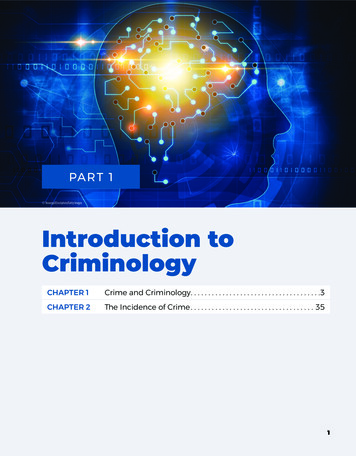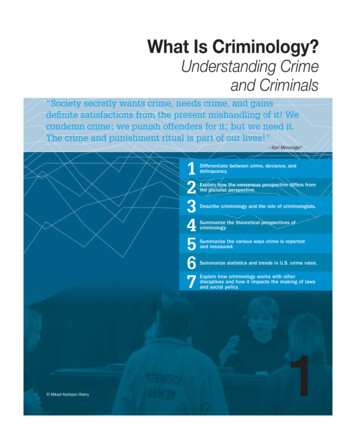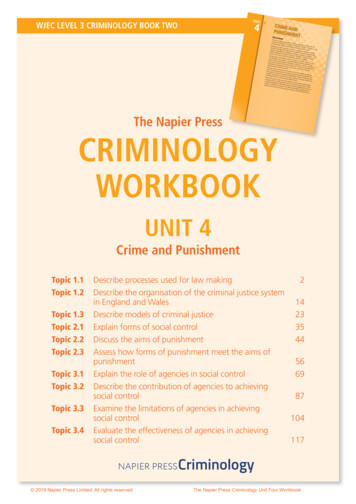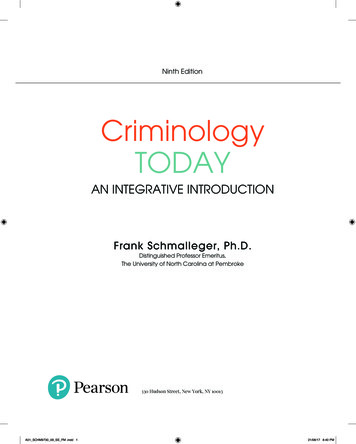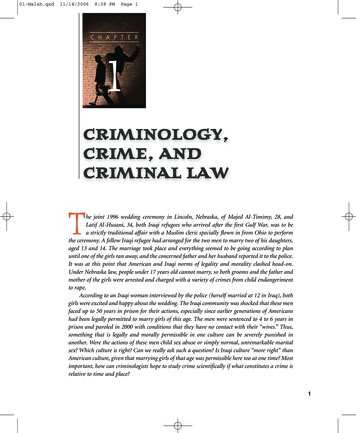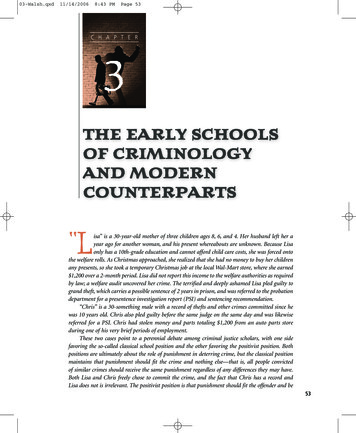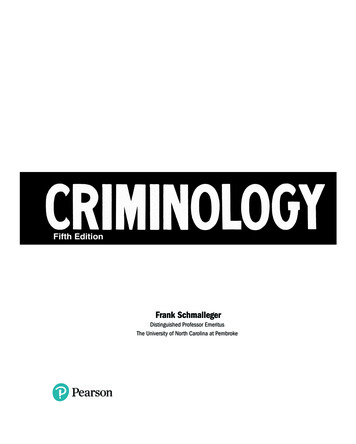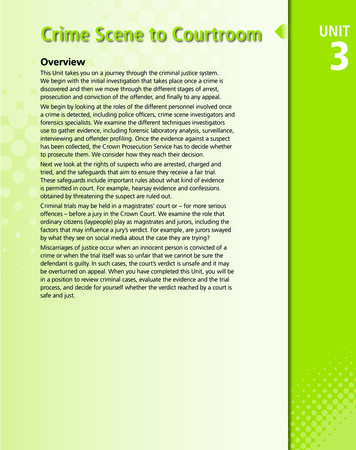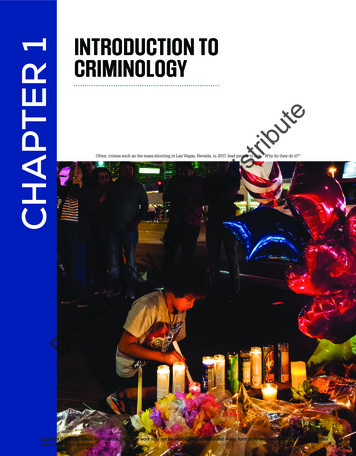
Transcription
istributeCHAPTER 1INTRODUCTION TOCRIMINOLOGYDonotcopy,post,ordOften, crimes such as the mass shooting in Las Vegas, Nevada, in 2017, lead people to ask, “Why do they do it?”Copyright 2021 by SAGE Publications, Inc. This work may not be reproduced or distributed in any form or by any means without express writtenpermission of the publisher.
LEARNING OBJECTIVESsecond person had gotten in on the conversation, claimingto be an attorney or a law enforcement officer. This personhad confirmed the scammer’s story. Afterward, the grandparent had been asked to wire money or send cash to payfor the “grandchild’s” bail. The scammer also had asked thegrandparent not to tell anyone of this situation, including hisor her parents.After reading this chapter, you will be able to:1.1Identify key concepts inunderstanding criminology.1.2Summarize the general structure andorganization of the criminal justice system.1.3Identify and characterize a good theory.1.4Identify key concepts and issuesassociated with victimology.teGenerally, the “grandparent scam” follows this type ofpattern:Case Studyistribu A grandparent gets a call from someone posing ashis or her grandchild. The caller explains that he or she is in trouble, witha story such as “There’s been an accident andI’m (in jail, in the hospital, stuck in a foreigncountry). I need your help.”The “Confidence Man”,ordOn July 8, 1849, The New York Herald, in its “PoliceIntelligence” section, reported the arrest of WilliamThompson. The Herald wrote that Thompson had beenscamming men he met on the streets of New York City.He had a “genteel appearance” and was very personable.After a brief conversation with the target of his scam (i.e.,the “mark”), Thompson would ask, “Have you confidencein me to trust me with your watch until tomorrow?” Thetarget, possibly thinking that Thompson was a forgottenacquaintance, would give him his watch.1 The caller provides just enough detail to make thestory seem believable.,post Next, the caller informs the grandparent that a thirdperson, such as a lawyer, doctor, or police officer,will explain all of this if the grandparent will call thatperson.tcopyThe Herald thus disdainfully labeled Thompson a“confidence man,” and the term soon became partof the American vernacular. It is unclear as to why the“Confidence Man” article drew so much attention.However, it gave birth to varying phrases such as “confidence game” and “con man.”2DonoIn November 2018, it was reported that numerousgrandparents in Kentucky were victims of what Kentucky’sattorney general, Andy Beshear, called the “grandparentscam.”3 Essentially, the victims reported that they hadreceived a call from someone claiming to be their grandchild. The “grandchild” had said that he or she was in jailin another state following his or her arrest for driving underthe influence and causing an automobile accident. Then, a iStockphoto.com/Gain Sapienza The caller asks the grandparent to send or wiremoney but “Don’t tell Mom and Dad.”4According to the Federal Trade Commission, in 2018 onein four people 70 years or older sent money to an imposterwhom they believed to be a family member or friend.The median individual loss for these victims of fraud was 9,000.5The “Confidence Man” and the “grandparent scam”are separated by more than 170 years; the technologicalexpertise needed to carry out these crimes significantlychanged during this time. However, what links these twocases is motive—monetary gain. This is one of the mostfascinating questions in the study of crime—althoughtechnology has changed how certain crimes are committed (e.g., internet fraud), have the explanations (i.e., “whythey do it”) changed?Chapter 1 Introduction to Criminology1Copyright 2021 by SAGE Publications, Inc. This work may not be reproduced or distributed in any form or by any means without express writtenpermission of the publisher.
IntroductionistributeWhen introducing students to criminology, it is essential to stress how various concepts andprinciples of theoretical development are woven into our understanding of, as well as our policy on, crime. This chapter begins with a brief discussion of such concepts as crime, criminal,deviant, criminology, criminal justice, and consensus and conflict perspectives of crime. The following section presents a general summary of the different stages of the adult criminal justicesystem, as well as the juvenile justice system. Next, this chapter illustrates how criminologyinforms policies and programs. Unfortunately, there are instances when policies are notfounded on criminological theory and rigorous research but are more of a “knee-jerk” reaction to perceived problems. The concluding section provides an overview of victimology andvarious issues related to victims of crime.What Is a Crime?Do,ordostnodeviance: behaviors that arenot normal; includes manyillegal acts, as well as activitiesthat are not necessarilycriminal but are unusual andoften violate social norms.,pmala prohibita: acts that areconsidered crimes primarilybecause they have beenoutlawed by the legal codes inthat jurisdiction.opymala in se: acts that areconsidered inherently evil.There are various definitions of crime. Many scholars have disagreed as to what should beconsidered a crime. For instance, if one takes a legalistic approach, then crime is that whichviolates the law. But should one consider, also, whether certain actions cause serious harm? Ifgovernments violate the basic human rights of their citizens, for example, are they engagingin criminal behavior?6As illustrated by these questions, the issue with defining crime from a legalistic approachis that one jurisdiction may designate an action as a crime while another does not. Some acts,such as murder, are against the law in most countries as well as in all jurisdictions of the UnitedStates. These are referred to as acts of mala in se (Latin, “evil in itself”), meaning the act is“inherently and essentially evil, that is immoral in its nature and injurious in its consequence,without any regard to the fact of its being noticed or punished by the law of the state.”7Other crimes are known as acts of mala prohibita, which means “a wrong prohibited;an act which is not inherently immoral, but becomes so because its commission is expresslyforbidden by positive law.”8 For instance, in the last few years there has been considerabledecriminalization of marijuana. Some states have legalized medical marijuana, while othershave legalized both recreational and medical marijuana.This text focuses on both mala in se and mala prohibita offenses, as well as other acts ofdeviance. Deviant acts are not necessarily against the law but are considered atypical andmay be deemed immoral. For example, in Nevada in the 1990s, a young man watched hisfriend (who was later criminally prosecuted) kill a young girl in a casino bathroom. He nevertold anyone of the murder. While most people would consider this highly immoral, at thattime, Nevada state law did not require people who witnessed a killing to report it to authorities. This act was deviant, because most would consider it immoral; yet it was not criminal,because it was not against the laws of that jurisdiction. It is essential to note that as a result ofthis event, Nevada changed its laws to make withholding such information a criminal act.Other acts of deviance are not necessarily seen as immoral but are considered strangeand violate social norms. One example of such acts is purposely belching at a formal dinner.These types of deviant acts are relevant even if not considered criminal under the legal definition, because individuals engaging in these types of activities reveal a disposition toward antisocial behavior often linked to criminal behavior. Further, acts that are frowned upon by mostpeople (e.g., using a cell phone while driving or smoking cigarettes in public) are subject tobeing declared illegal. Many jurisdictions are attempting to have these behaviors made illegaland have been quite successful, especially in New York and California.While most mala in se activities are also considered highly deviant, this is not necessarilythe case for mala prohibita acts. For instance, speeding on a highway (a mala prohibita act)—although it is illegal—is not technically deviant, because many people do it.This book presents theories for all these types of activities, even those that do not violate the law.9tccrime: there are variousdefinitions of crime. From alegalistic approach, crime isthat which violates the law.2Introduction to CriminologyCopyright 2021 by SAGE Publications, Inc. This work may not be reproduced or distributed in any form or by any means without express writtenpermission of the publisher.
What Are Criminology and Criminal Justice?istributhe body of knowledge regarding crime as a social phenomenon. It includes within itsscope the process of making laws, of breaking laws, and of reacting toward the breaking of laws. . . . The objective of criminology is the development of a body of generaland verified principles and of other types of knowledge regarding this process of law,crime, and treatment or prevention.11criminology: the scientificstudy of crime and the reasonswhy people engage (or don’tengage) in criminal behavior.teThe term criminology was coined by Italian law professor Raffaele Garofalo in 1885 (inItalian, criminologia). In 1887, anthropologist Paul Topinard invented its French cognate(criminologie).10 In 1934, American criminologist Edwin Sutherland defined criminology ascriminal justice: often refersto the various criminal justiceagencies and institutions (e.g.,police, courts, and corrections)that are interrelated.opy,post,ordCriminology is the scientific study of crime, especially the reasons for engaging incriminal behavior. While other textbooks may provide a more complex definition of crime,the word “scientific” distinguishes our definition from other perspectives and examinations of crime.12 Philosophical and legal examinations of crime are based on logic anddeductive reasoning—for example, by developing what makes logical sense. Journalistsplay a key role in examining crime by exploring what is happening in criminal justice andrevealing injustices as well as new forms of crime. However, the philosophical, legal, andjournalistic perspectives of crime are not scientific, because they do not involve the use ofthe scientific method.Criminal justice often refers to the various criminal justice agencies and institutions(e.g., police, courts, and corrections) that are interrelated and work together toward commongoals. Interestingly, many scholars who have referred to criminal justice as a “system” havedone so only as a way to collectively refer to those agencies and organizations, rather thanto imply that they are interrelated.13 Some individuals argue that criminal justice system is anoxymoron. For instance, Joanne Belknap noted that she preferred to use the terms crime processing, criminal processing, and criminal legal system, given that “the processing of victims andoffenders [is] anything but ‘just.’”14The Consensus and Conflict Perspectives of Crimeconsensus perspective:theories that assume thatvirtually everyone is inagreement on the laws andtherefore assume no conflictin attitudes regarding the lawsand rules of society.DonotcA consensus perspective of crime views the formal system of laws, as well as the enforcement of those laws, as incorporating societal norms for which there is a broad normativeconsensus.15 The consensus perspective developed from the writings of late-19th- and early20th-century sociologists such as Durkheim, Weber, Ross, and Sumner.16 This perspective assumes that individuals, for the most part, agree on what is right and wrong, as well ason how those norms have been implemented in laws and the ways in which those laws areenforced. Thus, people obey laws not for fear of punishment but rather because they haveinternalized societal norms and values and perceive these laws as appropriate.17 The consensus perspective was dominant during the early part of the 20th century. Since the 1950s,however, no major theorist has considered this to be the best perspective of law. Further, “tothe extent that assumptions or hypotheses about consensus theory are still given credence incurrent theories of law, they are most apt to be found in ‘mutualist’ models.”18Around the 1950s, the conf lict perspective began challenging the consensusapproach.19 The conflict perspective maintains that there is conflict between various societal groups with different interests. This conflict is often resolved when the group in powerachieves control.Several criminologists, such as Richard Quinney, William Chambliss, and Austin Turk,maintained that criminological theory has placed too much emphasis on explaining criminalbehavior, and it needs to shift its focus toward explaining criminal law. That is, the emphasisconflict perspective: theoriesof criminal behavior thatassume that most peopledisagree on what the lawshould be and that law is ameans by which those in powermaintain their advantage.Chapter 1 Introduction to Criminology3Copyright 2021 by SAGE Publications, Inc. This work may not be reproduced or distributed in any form or by any means without express writtenpermission of the publisher.
LEARNING CHECK 1.1istribu1. Crime that is evil in itself is referred to as mala .teshould not be on understanding the causes of criminal behavior; rather, it should be on understanding the process by which certain behaviors and individuals are formally designated ascriminal. From this perspective, instead of asking, “Why do some people commit crimeswhile others do not?” one would ask, “Why are some behaviors defined as criminal while others are not?” Asking these types of questions raises the issue of whether the formulation andthe enforcement of laws equally serve the good of all, not just the interests of those with thepower to influence such matters.202. Acts that are not necessarily against the law but are considered atypical and may beconsidered more immoral than illegal are acts.,ord3. Criminology is distinguished from other perspectives of crime, such as journalistic,philosophical, or legal perspectives, because it involves the use of the .Answers at www.edge.sagepub.com/schram3eThe Criminal Justice SystemostAccording to the 1967 President’s Commission on Law Enforcement and Administration ofJustice:,pany criminal justice system is an apparatus society uses to enforce the standards ofconduct necessary to protect individuals and the community. It operates by apprehending, prosecuting, convicting, and sentencing those members of the communitywho violate the basic rules of group existence.21tcopyThis general purpose of the criminal justice system can be further simplified into threegoals: to control crime, to prevent crime, and to provide and maintain justice. The structureand organization of the criminal justice system has evolved in an effort to meet these goals.There are three typically recognized components: law enforcement, courts, and corrections.22Law EnforcementDonoLaw enforcement includes various organizational levels (i.e., federal, state, and local). Oneof the key features distinguishing federal law enforcement agencies from state or local agencies is that they have often been established to enforce specific statutes. Thus, their units arehighly specialized and often associated with specialized training and resources.23 Federallaw enforcement agencies include the Federal Bureau of Investigation (FBI), the DrugEnforcement Administration (DEA), the Secret Service, the Marshals Service, and theBureau of Alcohol, Tobacco, Firearms, and Explosives (ATF). Further, almost all federalagencies, including the Postal Service and the Forest Service, have some police power. In2002, President George W. Bush restructured the federal agencies, resulting in the establishment of the Department of Homeland Security (DHS) in 2003. The DHS was created inan effort to protect and defend the United States from terrorist threats following theSeptember 11, 2001, attacks on New York and Washington, DC.24The earliest form of state police agency to emerge in the present-day United States was theTexas Rangers, founded by Stephen Austin in 1823. By 1925, formal state police departmentsexisted throughout most of the country. While some organizational variations exist among4Introduction to CriminologyCopyright 2021 by SAGE Publications, Inc. This work may not be reproduced or distributed in any form or by any means without express writtenpermission of the publisher.
state police: agencies withgeneral police powers toenforce state laws as well as toinvestigate major crimes; theymay have intelligence units,drug-trafficking units, juvenileunits, and crime laboratories.highway patrol: one type ofmodel characterizing statewidepolice departments. Theprimary focus is to enforce thelaws that govern the operationof motor vehicles on publicroads and highways.,ordistributethe different states, two models generally characterize the structure of these state policedepartments.The first model can be designated as state police. Michigan, New York, Pennsylvania,Delaware, Vermont, and Arkansas are states that have a state police structure. These agencies have general police powers and enforce state laws as well as perform routine patrols andtraffic regulation. They have specialized units to investigate major crimes, intelligence units,drug-trafficking units, juvenile units, and crime laboratories.The second model can be designated as highway patrol. California, Ohio, Georgia,Florida, and the Carolinas are states that have a highway patrol model. For these agencies,the primary focus is to enforce the laws that govern the operation of motor vehicles on publicroads and highways. In some instances, this includes not just enforcing traffic laws but investigating crimes that occur in specific locations or under certain circumstances, such as onstate highways or state property.25Agencies on the local level are divided into counties and municipalities. The primary lawenforcement office for most counties is that of county sheriff. In most instances, the sheriff isan elected position. The majority of local police officers are employed by municipalities. Mostof these agencies comprise fewer than 10 officers. Local police agencies are responsible forthe “nuts and bolts” of law-enforcement responsibilities. For instance, they engage in crimeprevention activities such as patrol their districts and investigate most crimes. Further, theseofficers are often responsible for providing social services, such as responding to incidents ofdomestic violence and child abuse.26ostCourtstcTT FIGURE 1.1opy,pThe United States does not have just one judicial system. Rather, the judicial system is quitecomplex. There are 52 different systems: one for each state, one for the District of Columbia,and one for the federal government. Given this complexity, however, one can characterizethe United States as having a dual court system. This dual court system consists of separate yetinterrelated systems: the federal courts and the state courts. While there are variations amongthe states in terms of judicial structure, usually a state court system consists of different levelsor tiers, such as lower courts, trial courts, appellate courts, and the state’s highest court. Thefederal court system is a three-tiered model: district courts (i.e., trial courts) and other specialized courts, courts of appeals, and the Supreme Court (see Figure 1.1).27DonoThree-Tiered Model of the Federal Court SystemThe U.S.SupremeCourtU.S. Courts ofAppealsU.S. District Courts1 Court13 Circuits: 12 Regionaland 1 Federal Circuit94 Districts: Each has aBankruptcy Court plus U.S.Court of International Tradeand U.S. Court of FederalClaimsSource: Adapted from ederal-courts.Chapter 1 Introduction to Criminology5Copyright 2021 by SAGE Publications, Inc. This work may not be reproduced or distributed in any form or by any means without express writtenpermission of the publisher.
Before any case can be brought to a court, that court must have jurisdiction over those individuals involved in the case. Jurisdiction is the authority of a court to hear and decide caseswithin an area of the law (i.e., subject matter such as serious felonies, civil cases, or misdemeanors) or a geographic territory.28 Essentially, jurisdiction is categorized as limited, general,or appellate:teCourts of limited jurisdiction. These are also designated as “lower courts.” They donot have power that extends to the overall administration of justice; thus, they do not tryfelony cases and do not have appellate authority.Courts of general jurisdiction. These are also designated as “major trial courts.” They havethe power and authority to try and decide any case, including appeals from a lower court.istribulimited jurisdiction: theauthority of a court to hear anddecide cases within an areaof the law or a geographicterritory.Courts of appellate jurisdiction. These are also designated as “appeals courts.” They arelimited in their jurisdiction decisions on matters of appeal from lower courts and trialcourts.29Donotcopy,post,ordEvery court, including the U.S. Supreme Court, is limited in terms of jurisdiction.The U.S. Supreme Court in 2019. Front, left to right: Associate Justice Stephen Breyer, Associate Justice ClarenceThomas, Chief Justice John Roberts, Associate Justice Ruth Bader Ginsburg, Associate Justice Samuel Alito, Jr.Back, left to right: Associate Justice Neil Gorsuch, Associate Justice Sonia Sotomayor, Associate Justice ElenaKagan, and Associate Justice Brett Kavanaugh.Chip Somodevilla/Getty Images North America/Getty ImagesCorrectionsprobation: essentially anarrangement between thesentencing authorities and theoffender requiring the offenderto comply with certain termsfor a specified amount of time.6After an offender is convicted and sentenced, he or she is processed in the corrections system. An offender can be placed on probation, incarcerated, or transferred to some type ofcommunity-based corrections facility. Probation is essentially an arrangement between thesentencing authorities and the offender. While under supervision, the offender must complywith certain terms for a specified amount of time to return to the community. These termsare often referred to as conditions of probation.30 General conditions may include a requirementIntroduction to CriminologyCopyright 2021 by SAGE Publications, Inc. This work may not be reproduced or distributed in any form or by any means without express writtenpermission of the publisher.
jail: jails are often designatedfor individuals convicted ofa minor crime and to houseindividuals awaiting trial.istributeto regularly report to one’s supervising officer, submit to searches, and not be in possession offirearms or use drugs. Specific conditions can also be imposed, such as participating in methadone maintenance, urine testing, house arrest, vocational training, or psychological or psychiatric treatment.31 There are also variations to probation. For instance, a judge can combineprobation with incarceration, such as in shock incarceration, which involves sentencing theoffender to a certain amount of time each week (often over the weekend) in jail or anotherinstitution; in the interim periods (e.g., Monday–Friday), the offender is on probation.Some offenders are required to serve their sentences in a corrections facility. One typeof corrections facility is jail. Jails are often designated for individuals convicted of minorcrimes. Jails are also used to house individuals awaiting trial; these people have not been convicted but are incarcerated for various reasons, such as preventative detention. Another typeof corrections facility is prison. People sentenced to prison are often those who have beenconvicted of more serious crimes with longer sentences. There are different types of prisonsbased on security concerns, such as supermax, maximum-security, medium-security, andminimum-security. Generally, counties and municipalities operate jails, while prisons areoperated by federal and state governments.32Given the rising jail and prison populations, there has been increased use of alternatives totraditional incarceration. Residential sanctions, for example, include halfway houses as wellas work-release and study-release. Nonresidential sanctions include house arrest, electronicmonitoring, and day reporting centers.33,ordprison: generally for thoseconvicted of more seriouscrimes with longer sentences,who may be housed in asupermax-, maximum-,medium-, or minimum-securityprison, based on securityconcerns.The Juvenile Justice SystemDonotcopy,postIn America prior to the 19th century, children were treated the same as adults in terms ofcriminal processing. Children were considered as “imperfect” adults or “adults in miniature.” They were held to the same standards of behavior as adults. The American colonistsbrought with them the common law doctrine from England, which held that juveniles sevenyears or older could be treated the same as adult offenders. Thus, they were incarcerated withadults and could receive similarly harsh punishments, including the death penalty. It shouldbe noted, however, that youths rarely received such harsh and severe punishments.34Beginning in the early 19th century, many recognized the need for a separate system forjuveniles.35 For instance, Johann Heinrich Pestalozzi, a Swiss educator, maintained that children are distinct from adults, both physically and psychologically.While there is some disagreement in accrediting the establishment of the first juvenilecourt, most acknowledge that the first comprehensive juvenile court system was initiated in1899 in Cook County, Illinois. One key to understanding the juvenile justice system is theconcept of parens patriae. This Latin term literally means “parent of the country.” Thisphilosophical perspective recognizes that the state has both the right and the obligation tointervene on behalf of and to protect its citizens who have some impairment or impediment—such as mental incompetence or, in the case of juveniles, immaturity. The primary objective of processing juveniles was to determine what was in the best interest of the child. Thisresulted in the proceedings resembling a civil case more than a criminal case. The implicationof this approach was that the juvenile’s basic constitutional rights were not recognized; theserights included the right to confrontation and cross-examination of the witnesses, the rightto protection against self-incrimination, and compliance regarding the rules of evidence.Another difference between the juvenile justice system and the adult criminal justice systemis the use of different terms for similar procedures (see Table 1.1).During the 1960s, there was a dramatic increase in juvenile crime. The existing juvenilejustice system came under severe criticism, including questions concerning the informal procedures of the juvenile courts. Eventually, numerous U.S. Supreme Court decisions challenged these procedures, and some maintained that these decisions would radically changeparens patriae: a philosophicalperspective that recognizesthat the state has both the rightand the obligation to interveneon behalf of its citizens in thecase of some impairment orimpediment—such as mentalincompetence or, in the case ofjuveniles, age and immaturity.Chapter 1 Introduction to Criminology7Copyright 2021 by SAGE Publications, Inc. This work may not be reproduced or distributed in any form or by any means without express writtenpermission of the publisher.
TT TABLE 1.1Juvenile vs. Criminal Justice System TerminologyCriminal Justice SystemAdjudicated delinquent – Found to have engaged in delinquent conductConvictAdjudication hearing – A hearing to determine whether there is evidencebeyond a reasonable doubt to support the allegations against thejuvenileTrialAftercare – Supervision of a juvenile after release from an institutionParoleCommitment – Decision by a juvenile court judge to send theadjudicated juvenile to an institutionSentence to prisonistributeJuvenile Justice SystemCrimeDelinquent – A juvenile who has been adjudicated of a delinquent act injuvenile courtCriminalDetention – Short-term secure confinement of a juvenile for theprotection of the juvenile or for the protection of societyConfinement in jail,ordDelinquent act – A behavior committed by a juvenile that would havebeen a crime if committed by an adultJailDisposition – The sanction imposed on a juvenile who has beenadjudicated in juvenile courtSentenceDisposition hearing – A hearing held after a juvenile has beenadjudicatedSentencing hearingInstitution – A facility designed for long-term secure confinement of ajuvenile after adjudication (also referred to as a training school)PrisonPetition – A document that states the allegations against a juvenile andrequests a juvenile court to adjudicate the juvenileIndictmentTaken into custody – The action on the part of a police officer to obtaincustody of a juvenile accused of committing a delinquent actArrestedopy,postDetention center – A facility designed for short-term secure confinementof a juvenile prior to court disposition or execution of a court ordertcSource: Taylor, R. W., & Fritsch, E. J. (2015). Juvenile justice: Policies, programs, and practices (4th ed.). New York, NY: McGraw-Hill Education, p. 9. Used with permissionfrom McGraw-Hill Education.Donothe nature of processing juveniles. For instance, in the case In re Gault (1967), the U.S.Supreme Court ruled that a juvenile is entitled to certain due-process protections constitutionally guaranteed to adults, such as a right to notice of the charges, right to c
Introduction to Criminology. Introduction. When introducing students to criminology, it is essential to stress how various concepts and . principles of theoretical development are woven into our understanding of, as well as our pol - icy on, crime. This chapter begins with

